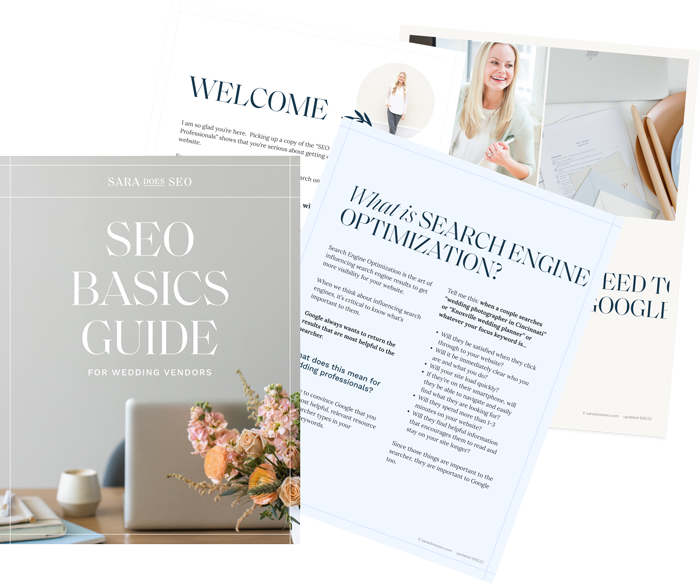
5 SEO Mistakes the Wedding Industry Keeps Making
I know you’re working hard to increase your visibility, and in many cases that means using SEO tactics on your website. You’ve read a few articles, and you’re doing your best to follow the SEO rules you know.
Unfortunately, I’m here to tell you that not every wedding industry SEO article you’ve read has good, updated advice.
As a consultant offering wedding vendor SEO services, I often discover in my SEO Roadmap process that wedding vendors are following outdated or spammy practices. They may have heard from a friend that these things work, or they may have read an article from 2013 about a tactic that used to be OK.
Today, though, getting found on Google isn’t about “tricks” and tactics. SEO is all about being helpful and relevant for the searcher.
So today, let’s talk about 5 big mistakes wedding vendors are making with SEO and the tactics you should stop using.
In this Post
5 Common Wedding Industry SEO Mistakes
1. Keyword Stuffing
Contrary to popular belief, the website that uses their city’s keyword the most is not the one who shows up first in Google.
Every day, I see wedding vendors who are trying to use their focus keyword (“wedding photographer in Jackson” for example) as much as humanly possible. It’s in their blog post titles, on every page, at the bottom of every blog post, etc.
This is known as keyword stuffing, and Google doesn’t like it. Over-use of your keyword may cause Google to view your website as spammy.
Instead of stuffing your focus keyword absolutely everywhere, here’s what I recommend:
- Choose one page on your website that you’d like to rank for your focus keyword (this may be your About page or your wedding service page).
- On that page, write in-depth content that would be very useful to someone who searched and landed on that page (maybe include FAQs, pricing, links to your recent weddings)
- Every time you mention “wedding photographer in Jackson” in your blog posts or other content, link that phrase back to your in-depth page
- Stop putting your focus keywords in your blog titles (please)
2. Spammy Image Naming
Somewhere in SEO history, someone wrote an article that said you should include all sorts of keywords in your image names and alt tags to rank on Google.
Forcing keywords into image names may have worked in 2010, but you absolutely shouldn’t do it today.
Google’s Search Engine Optimization Starter Guide specifies that you should use “brief, but descriptive filenames and alt text.” They tell us to avoid “writing extremely lengthy filenames” and “stuffing keywords into alt text.”
When it comes to images, do:
- Name them a brief name that describes what’s in the image
- Make sure to include helpful alt text that also accurately, briefly describes what’s in the image.
Do not:
- Title every image on your website “wedding-photographer-jackson.jpg”
- Write keyword-stuffed image titles like “best-wedding-photographer-jackson-wedding-reception-at-west-hills-country-club.jpg”
For more on images, don’t miss What Should I Name My Images for SEO?.
3. Not Writing Enough Content
To rank in search engines and really help users, web pages need words.
I know the temptation is to just write a brief introduction to a wedding in your featured gallery or in a blog post, and then to include tons of images to tell the story.
Unfortunately, that doesn’t really help Google to know what your page is about and if they should rank it in search results.
Instead, write a longer post that introduces the couple, shares the details, explains why some of the decisions were made for venue and decor, explains your role in the wedding day, and includes creative details.
I tell my clients to aim for at least 500 words per page or post, and bonus points if they can get it to 750-1000. I know that is a ton of writing, but this will clearly differentiate your site as the most helpful and relevant.
4. Not Writing Meta Titles and Descriptions
If you want searchers to click on your listing in search results, you have to make it interesting!
You do that first with your meta titles and descriptions. These are the title and small paragraph that show in search results for your website.

Did you know that you do have some control over these? While Google will sometimes pull in other information on the page to show in search results, it will do that less if you write an engaging, unique title and description.
I recommend writing custom meta titles and descriptions for your home page, major inner pages, and key blog posts.
Where you enter these meta titles and descriptions depends on your website platform and how your website was built. Either ask your web designer or search the help articles for your platform.
5. Over-Using Categories and Tags
The last most common mistake I see is complete abuse of categories and tags on blog posts.

So many wedding vendors think adding 30 similar tags to a blog post will help it rank. Unfortunately, this is another type of keyword stuffing, it’s spammy, and it should be avoided.
Instead, use categories and tags to actually group similar content together. If the user wouldn’t want to click on a tag to see similar blog posts, the tag shouldn’t be used.
Any tag that applies to all of your photos isn’t useful either. So no tagging your blog posts “wedding photographer in Jackson.”
Here are a few examples of relevant, helpful blog tags:
- Spring weddings
- Weddings in downtown Jackson
- Indoor weddings
- LBGTQ weddings
- Outdoor ceremonies
For more information on categories and tags, check out How to Use Categories and Tags on a Wedding Blog.
Overall, the goal in today’s SEO is to provide helpful content for your visitor. It is not to stuff keywords everywhere or use your target keyword the most. If you keep your website visitor and what they need top-of-mind, you are likely to win in both search engine rankings and in inquiries.

The SEO Basics Guide for Wedding Professionals
Get instant access to my top SEO tips, including only what's working right now.

Every creative wedding pro needs a geeky best friend. Let me help you and your work get found online.